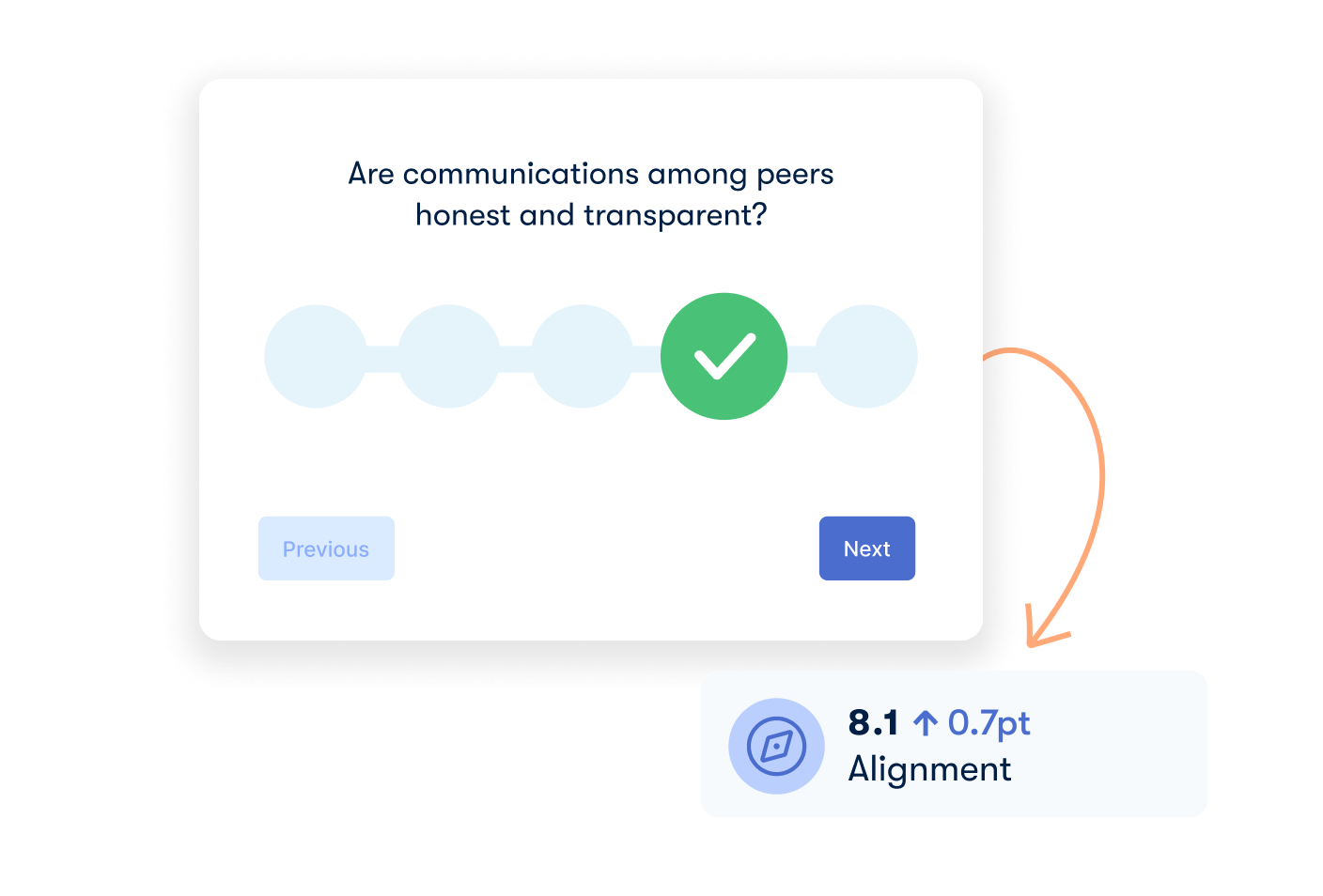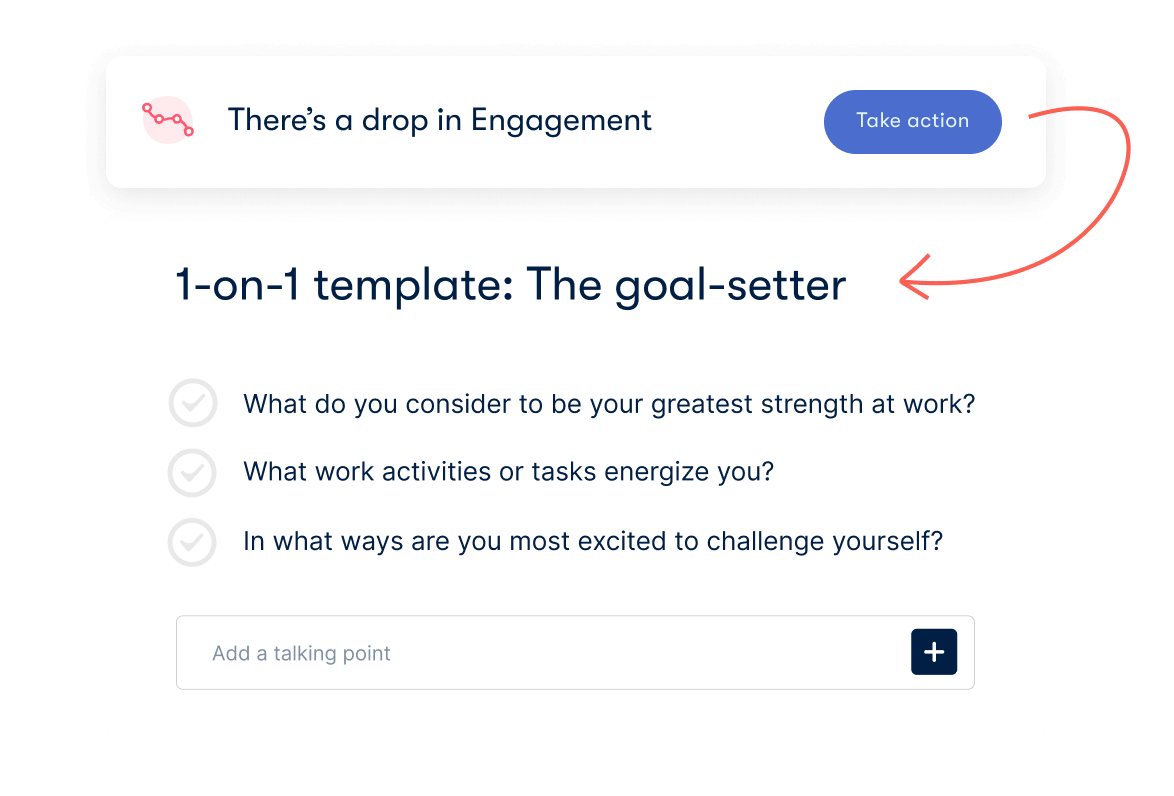A company's success depends in large part on employee engagement. When employees feel engaged, they produce their best work and contribute to a positive corporate culture. They invest themselves and their futures in the company for which they work.
Energy, passion, and commitment drive an engaged workforce toward higher employee satisfaction and resilience, better productivity, and more innovation.
According to Gallup's 2021 State of the Global Workplace Report, only 20% of employees worldwide feel engaged at work, down from 22% in 2019. Leaders must tackle this downward trend by building more engaged workforces.
As a manager, part of your role is to recognize the importance of employee engagement and help your team members discover (or rediscover) their inner strength, happiness, and enthusiasm. Let's look at why employee engagement is so critical, how it's measured, and what you can do to promote engagement in your employees.
Assess your organization’s employee experience in minutes

The value of employee engagement for teams:
Six reasons why employee engagement is important
Disengaged employees may not feel like themselves at work. They may contend with fatigue, stress, loneliness, sadness, and even anger.
On the other hand, engaged employees tend to be happy at work, feel valued by leadership, work with authentic energy, and find more satisfaction in their daily tasks.
Let's look a bit more closely at the primary benefits of employee engagement:
1. Productivity
Productivity isn't about how many hours your employees work in a day. It's about the quality of that work and the employee experience.
According to Gallup, business units with high employee engagement levels enjoy 18% more productivity.
It's not surprising that elevated employee engagement leads to increased productivity. Disengaged employees struggle to feel invested and often spend much of their days waiting to clock out.
Employees who are engaged with their work feel invested in the business and their contributions to it. They work with more motivation and energy and produce higher quality work.
2. Employee satisfaction
High productivity works hand-in-hand with high job satisfaction. An engaged employee feels connected to and fulfilled by their work.
Satisfied employees find support and belonging within the company's culture, feel valued and valuable, and feel celebrated when they go above and beyond for the business.
They enjoy a healthy work-life balance and show up with consistent enthusiasm, driving positive business outcomes and low employee turnover.

3. Employee retention
Human resources personnel and business leaders benefit from improved employee retention because their workforces are engaged.
Our data report, The state of employee experience, from here on out, looks at Officevibe Pulse Survey data from 2019 to 2021 to examine the many elements of employee experience and retention.
Roughly 30,000 Officevibe users take Pulse Surveys every day. Just over half (53%) of them reported that they have recently looked for other professional opportunities.
Employees hunt for new jobs for many reasons, but you can improve employee retention by increasing employee engagement. People stick around when they find pride and satisfaction in their jobs or careers.
4. Brand ambassadorship
By boosting employee engagement, you can quickly turn employees into steadfast brand ambassadors. Engaged and motivated employees who believe in the company's mission are keen to share their enthusiasm with others.
Just as employees cannot thrive without support from leadership, a successful business cannot succeed without the support of its employees.
Both customers and potential new hires trust the opinions of your current employees. Increased employee engagement means more word-of-mouth exposure, social media marketing, and great employer reviews that attract future talent.
5. Company culture
The entire company culture benefits when leaders increase employee engagement. In other words, when you use employee engagement strategies, you encourage higher morale on your team.
Your employees will want to support the company and each other. They will naturally develop an empowering workplace culture that you can strengthen using strategies like clear communication and regular recognition.
6. Customer satisfaction
When employee engagement is high, your workforce will approach your customers with a positive attitude. In contrast, low employee engagement can result in poor customer service.
Consider the last time you ate at a restaurant and had a clearly disengaged waiter serving you. Perhaps they were sluggish, bored, or distracted. Did you feel inclined to return to that restaurant any time soon? Probably not!

Customers can tell the difference between an engaged and disengaged employee. An engaged waiter is excited to see you, offers helpful menu tips, and makes you eager to return.
As a manager, when your employee engagement is high, your employees will bring those positive vibes to their customer interactions. Simply put, happy employees mean happy customers, leading to increased company success.
How do you measure employee engagement?
You can use several strategies to measure employee engagement effectively.
The key is employee communication. Give your employees the opportunity to communicate with you on a regular basis through surveys, one-on-one meetings, and interviews.
Employee surveys
Employee surveys provide invaluable information on how your team feels about their experiences as part of your staff.

You can measure employee engagement using surveys that prioritize important metrics, such as these 10 employee engagement metrics.
One-on-one meetings
Using what you learn from your employee surveys, you can conduct one-on-one meetings with each team member to celebrate accomplishments and address concerns.
Use one-on-one meetings to dig deeper into what's keeping each employee from being engaged.
💡 Click here for some essential tips on conducting successful one-on-one meetings from Officevibe.
Stay or exit interviews
Leaders conduct exit interviews when an employee leaves the team to learn more about their experience and to discuss some of the reasons for parting ways with the organization.
You can also use stay interviews to learn about possible issues before they result in the loss of a valuable team member. Use these stay interviews regularly to connect with your team and improve staff retention.
Employee Net Promoter Scores (eNPS)
A Net Promoter Score (NPS) is a single question you can ask customers and employees to measure loyalty. It reads, "How likely are you to recommend...?" and asks the respondent to choose a rating on a scale of one to 10.
The employee Net Promoter Score (eNPS) model proves very effective in measuring employee engagement.
Three strategies to improve employee engagement
We've established that employee engagement, important for so many reasons, is an essential consideration for company and team leaders.
Maintaining employee engagement is not a one-and-done affair. To continue benefitting from higher employee engagement, you must put in the work long-term.
Let's get into the actions you can take to improve employee engagement in your workforce.
1. Build development plans
Officevibe's Pulse Survey data tells us that 73% of employees believe they could receive more explicit goals from leadership. An engaged workforce knows precisely what their employer expects and what the business is working toward on a company and team level.
When you build a professional development plan for each employee, you support the employee in their growth by providing clear goals and expectations. Use one-on-one meetings to establish personal goals and the required steps to reach them.
When building an employee development plan, remember to consider each person's:
- Personal and company-related values
- Personal and company-related goals
- Education and mentorship opportunities
- Support and communication needs
- Physical wellness needs
- Mental health needs
According to our Officevibe Pulse Survey data, 26% of respondents feel that their organizations do not care about their mental health. By considering not just what proves best for the business but also what's best for the employee, you show that you care and are willing to offer help.
Every developmental plan will look different, which is why it's so important to include the employee in the conversation. For some great advice on conducting these one-on-one meetings, check out this Officevibe article about the GROW coaching model.
2. Build connections on your team
Showing your workforce that you care goes a long way towards improving employee engagement. Build connections on your team by providing a work environment where your employees feel valued and they belong.
Provide or help your employees find the resources to address physical and mental health issues. Encourage employee communication on these topics so that you can foster an inclusive culture of mutual respect.
You can also build connections on your team by letting employees participate in business decisions. An engaged workforce is invested in the company's success and wants to help establish and reach company goals.
Finally, encourage employees to give each other feedback.
According to our Pulse Survey data, 28% of respondents wish they received feedback from co-workers more often.
3. Give meaningful employee feedback
Disengaged employees often report infrequent feedback from company leaders. Our Pulse Survey data tells us that only 25% of employees feel that the frequency of the feedback they get from managers is sufficient to help them grow.
Effectively engaging employees means providing valuable feedback on a consistent basis. Highly engaged employees thrive on constructive feedback that provides actionable steps for improvement.
Employee engagement initiatives that get results include strategies for effective employee performance feedback.
Although the feedback sandwich model is not recommended, be sure that your feedback also includes opportunities for employee recognition. Your team members want and deserve praise when they do a good job or stay late to complete a project.
Give your staff props when props are due to improve employee engagement.
FAQs about engaged employees
Are engaged employees less likely to quit?
According to Gallup, businesses with the lowest employee engagement have a 43% higher turnover rate than those with the highest employee engagement. It's easy to understand why this is.
When you successfully engage employees, your workforce will be more invested in the business and more passionate about the work. That's why employee engagement, important for many other reasons, proves essential for retaining employees.
Employee engagement improves when team members feel heard, appreciated, and treated fairly. When employees feel ignored, underappreciated, or unfairly treated, they're not motivated to stick around.
Are engaged employees more productive?
Yes, to increase productivity and business success, leaders must consider employee engagement. Your employees will produce better quality work more efficiently when they feel engaged at work.
Gallup data tell us that businesses with the highest employee engagement benefit from 18% more productivity, 23% more profitability, and 81% less absenteeism compared to companies with the lowest engagement.
Employee engagement encourages more collaboration between workers, leaders, and staff. Employees understand what they are supposed to do and how to do it. They actively engage with organizational drivers, resulting in more production and innovation.
Are engaged employees happier?
Employee engagement may not be synonymous with happiness, but these concepts are intertwined all the same. Employee engagement encourages a positive employee experience.
Will engaged employees exude happiness every single day for eight straight hours? Not likely—but they will likely be happier overall in their personal and professional lives.
Engaged employees:
- Maintain a comfortable work-life balance
- Tackle work difficulties like stress head-on
- Feel valued at work
- Find joy in using their unique skillsets
- Find fulfillment in their jobs
All of these aspects of effective employee engagement garner happier employees.
Using the right employee engagement software
Improving employee engagement can prove daunting for direct managers and other business leaders. As a leader, you understand why employee engagement is essential to your business strategy. Still, you may be wondering how you're supposed to manage all the tasks that go into keeping a workforce engaged in addition to your regular workload.
Luckily, today's technology-driven world includes services that make employee engagement easier. Automated platforms like Officevibe's Employee Engagement Solution provide all of the tools you need to measure and improve engagement and organizational performance.
Officevibe's solution allows employees to answer weekly Pulse Surveys and provide anonymous feedback to you and other company leaders. Our system produces easy-to-read reports with actionable insights to help you address tough issues and find new solutions.

Our Employee Engagement Solution can help you gather and interpret your company's engagement data. Officevibe offers solution-driven data to help you improve engagement for your current and new employees, improve employee loyalty, and build a stronger, more connected company.
Officevibe is simple to start and easy to use. Your team will thank you for it. Reach out to us today.
Equip HR and managers with tools to engage, recognize, and drive performance.




